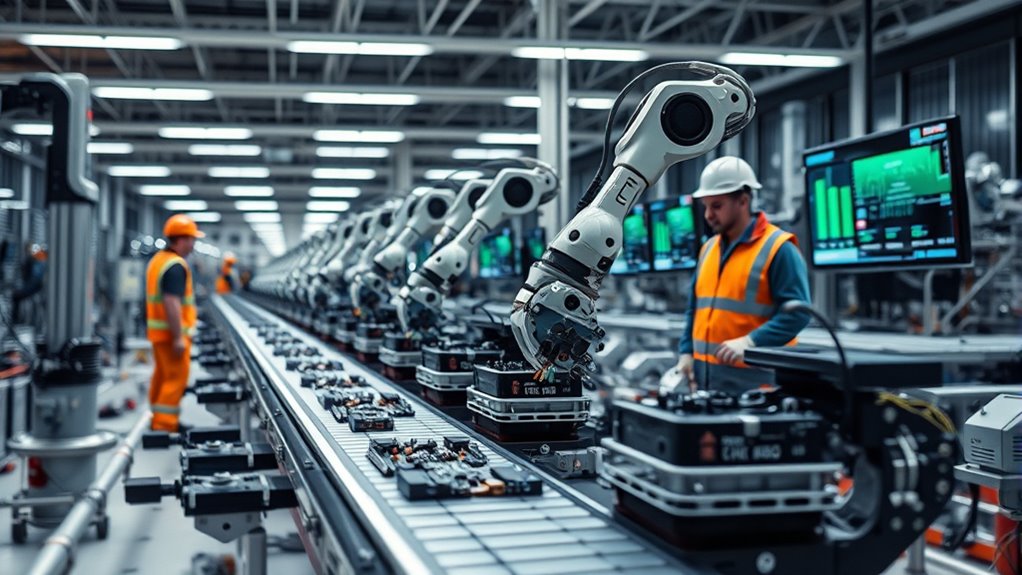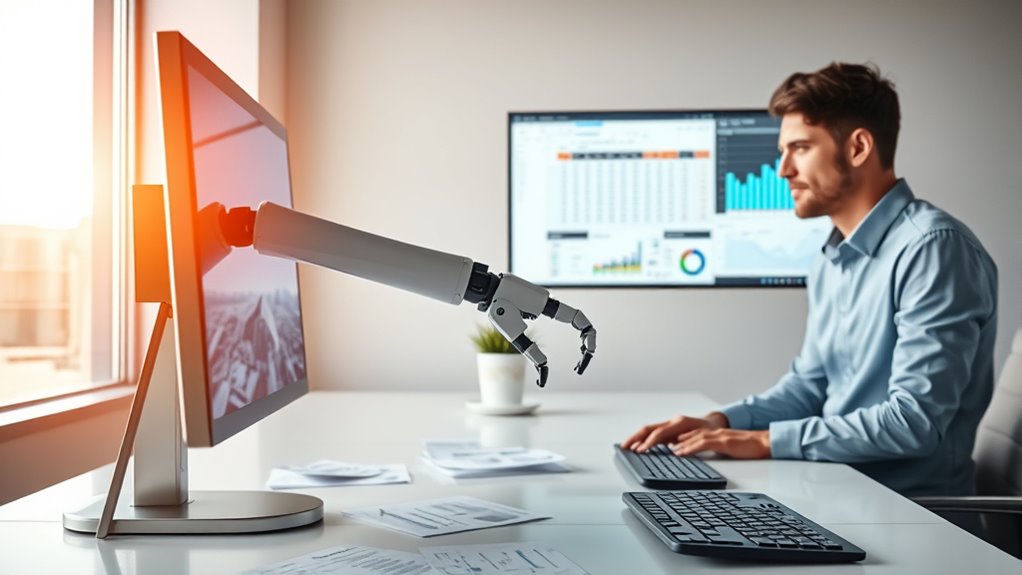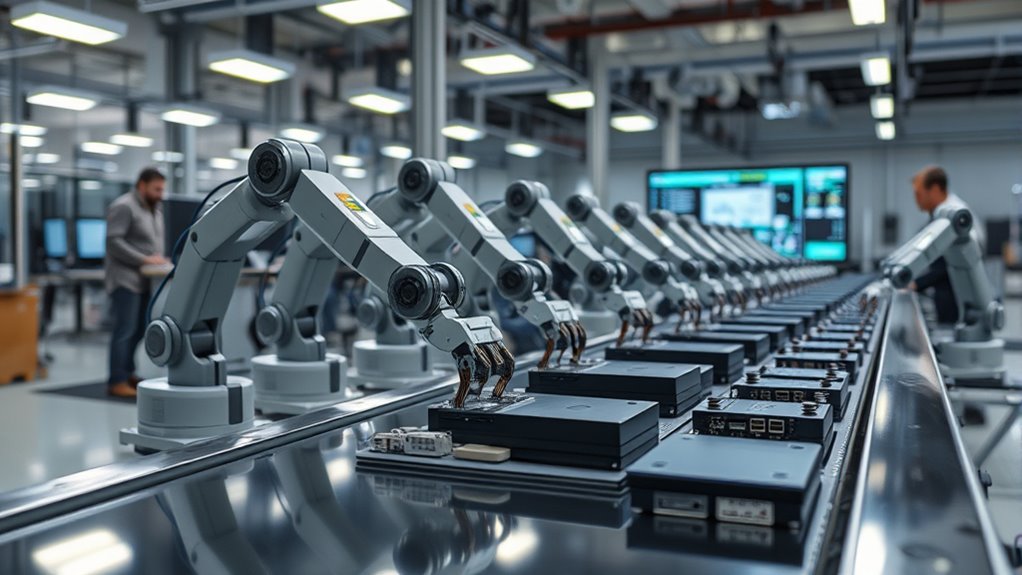Jobs in administrative, retail, healthcare support, manufacturing, and IT are next to face significant automation. Tasks like data entry, customer service, and routine tasks are increasingly handled by AI, RPA, and robots. Roles that involve repetitive work or manual processes are most vulnerable, but many will evolve with new skills. If you want to understand how these changes could affect you—and what opportunities may come next—keep exploring these sectors further.
Key Takeaways
- Administrative and clerical roles, especially routine tasks like data entry and scheduling, are highly susceptible to automation.
- Retail jobs such as cashiers and stock clerks face significant displacement due to increased automation in stores.
- Healthcare support functions like billing, appointment scheduling, and documentation are increasingly automated with AI tools.
- Manufacturing and production roles are at high risk, with many tasks replaced by industrial robots and automated systems.
- IT and tech jobs, including incident response and system management, are vulnerable as automation becomes more prevalent.
Administrative and Clerical Roles

Have you noticed how many routine administrative tasks are being taken over by AI and automation? It’s happening fast, especially in clerical roles. About 26% of office jobs face automation risk, according to McKinsey. Tasks like data entry, scheduling, and document management are most vulnerable. Repetitive, rule-based processes—such as invoicing, email sorting, and appointment setting—are now handled by robotic process automation (RPA) and AI systems. Advanced tools process forms and manage databases with little human oversight, replacing manual record-keeping. Administrative jobs in developed economies are especially affected, with automation reducing demand for traditional clerical workers. Over 2.5 million industrial robots are in use globally, which highlights the rapid expansion of automation technologies across sectors. To stay relevant, you’ll need to develop digital, analytical, and problem-solving skills. Adapting to changing technological landscapes will be essential for future roles, which will likely involve overseeing automated processes rather than executing manual tasks. Recognizing automation trends and understanding email marketing tools can help professionals better prepare for upcoming shifts in job requirements. Additionally, understanding potential pitfalls in adopting new payment technologies can be crucial for businesses adapting to digital transformation. Emphasizing software quality assurance practices can also help ensure that automated systems function reliably and securely in evolving workplaces.
Retail and Sales Positions

Are retail and sales jobs really safe from automation? Not quite. High-risk roles like cashiers, stock clerks, and customer service reps face significant automation threats. By 2040, up to 41 million retail jobs could disappear due to automation, with the industry expected to be 60-65% automated soon. Retail employs around 16 million Americans, so millions could be displaced, especially women, who make up 73% of cashier roles. Meanwhile, the sales automation market is growing rapidly, with AI expected to transform 74% of sales roles by 2025. Automation boosts efficiency, reduces errors, and increases ROI, but it also risks job displacement. As technology advances, many retail and sales positions will be reshaped or eliminated, demanding new skills and adaptability from workers.
Healthcare Support Jobs

Could healthcare support jobs be at risk from automation? Yes, many routine tasks are increasingly handled by AI and digital tools. Data entry, appointment scheduling, billing, and coding are prime targets, with automation reducing manual effort and errors. Tasks like patient reminders, outreach, inventory management, and transcription are also being automated through chatbots, intelligent platforms, and voice-to-text tools. Digital check-ins and online forms lessen the need for in-person registration staff. AI supports preliminary diagnostics and remote monitoring, streamlining workflows. Additionally, the integration of healthcare technology is transforming service delivery, leading to more efficient workflows. The adoption of digital health tools is also contributing to the shift in skill requirements for support staff. While automation takes over repetitive duties, it allows support staff to focus on more complex, personalized care. The healthcare AI market is projected to exceed $120 billion by 2028, reflecting rapid technological adoption across the sector. As automation becomes more prevalent, the importance of digital literacy among healthcare support staff will only grow. Moreover, the increasing use of robotic process automation is expected to further enhance productivity and accuracy in healthcare settings. In addition, ongoing developments in machine learning are poised to expand the scope of support tasks that can be automated, making adaptability even more crucial for workers.
Manufacturing and Production Occupations

Automation has profoundly reshaped manufacturing and production jobs, leading to significant changes in how goods are made. You’ll see automation replacing many roles and demanding new skills. Here’s what’s happening:
- Over 1.7 million manufacturing jobs have been lost since 2000 due to automation.
- Around 2.5 million industrial robots worldwide impact manufacturing roles.
- By 2025, about 2 million workers could be replaced by automation and AI systems.
- Nearly half of energy, utilities, and mining jobs face high automation risk by 2030.
- Global projections indicate that 300 million jobs could be lost to AI by 2025, highlighting the urgent need for workforce adaptation in this sector.
- To stay relevant, workers need skills in AI, robotics, and data analytics. Maintenance, inspection, and repair roles are critical, and up-skilling is essential in this rapidly evolving landscape and the increasing integration of automation technologies. Additionally, understanding the tax implications of automation investments can help companies optimize their operational costs and strategic planning. Recognizing the importance of regulatory compliance can also ensure smoother implementation of automation systems and avoid potential legal issues. Staying informed about industry standards can further facilitate the adoption of automation and help avoid costly errors.
Technology and IT Careers

As automation transforms the way IT work gets done, many roles are becoming more exposed to technological change. With 60% of jobs in advanced economies at risk of AI-driven automation, IT roles are highly vulnerable due to their automation potential. You’ll find that 93% of IT workers using automation tools report higher productivity, indicating rapid adoption. By 2025, 70% of organizations plan to implement structured automation, up from 20% in 2021. Tasks like patch management and incident response are increasingly automated, while 88% of IT professionals prioritize self-service features for users. To stay relevant, you’ll need skills in AI, automation, and data management, as cybersecurity strategies become essential to safeguard AI systems and data security. Continuous learning becomes essential in this rapidly changing landscape. Ongoing skill development is crucial to keep pace with emerging technologies and maintain employability in the sector. Additionally, fostering creative problem-solving skills can help IT professionals adapt to unforeseen challenges presented by automation. Embracing technological adaptability will also be key to thriving as the industry continues to evolve.
Data Entry and Processing Tasks

Automation is transforming data input tasks, making processes faster and more reliable. With advanced software replacing manual work, accuracy and speed see significant improvements. As technology advances, more jobs may shift away from routine data entry toward oversight and analysis. Additionally, cybersecurity measures are increasingly crucial to protect sensitive information during these automated processes, highlighting the importance of cybersecurity vulnerabilities. Understanding efficient general ledger coding can also help organizations ensure financial compliance amid automation.
Automation of Data Input
Despite the growing presence of automation, data input tasks like data entry and processing remain essential in many businesses. You’ll see that:
- Job postings for Data Entry Specialists grew by 7% last year, showing ongoing demand.
- 94% of companies perform repetitive tasks, including data input, which are ripe for automation.
- AI and automation tools are advancing quickly, boosting efficiency and reducing manual effort.
- Automation can cut manual errors by up to 90%, ensuring more accurate data processing.
- Fostering a digital-friendly environment at home is crucial for supporting digital literacy and preparing children for future technological changes.
While automation improves speed and reduces mistakes, the need for skilled data entry professionals persists, especially for complex or nuanced tasks. Businesses are shifting focus toward higher-value activities, but data input still plays a crucial role across sectors.
Accuracy and Speed Gains
The improvements in accuracy and speed brought by automation are transforming how data entry and processing tasks are handled across industries. Automated systems reduce human errors, ensuring more reliable records and boosting financial accuracy through AI-driven invoice processing. They quickly detect anomalies and fraud, strengthening security. Consistent data formatting and validation are maintained effortlessly, minimizing deviations. Speedwise, automation processes large datasets in seconds, replacing hours or days of manual work. Invoice approvals accelerate, speeding up payment cycles, while bulk imports and exports happen instantly. Real-time updates and seamless synchronization across systems eliminate delays, and manual routing is replaced by instant digital workflows. These gains increase productivity, freeing employees from repetitive tasks and enabling them to focus on higher-value work. Automation support also leads to cost savings by reducing the need for extensive manual labor.
Software Replacing Manual Tasks
As technology advances, software solutions are increasingly replacing manual data entry and processing tasks, making workflows faster and more accurate. You’ll notice automation transforming industries by improving efficiency and reducing errors. Consider these points:
- Automation accelerates data tasks, cutting processing time markedly.
- Advanced AI, machine learning, and RPA enable businesses to automate complex functions.
- Automated systems improve data quality by minimizing human errors.
- Scalability allows handling large data volumes effortlessly, supporting business growth.
Despite a 7% increase in data entry job postings, automation reduces the need for manual input. By streamlining processes and boosting accuracy, automation frees up resources for strategic tasks. The future points toward broader digital transformation, making manual data entry increasingly obsolete.
Customer Service and Client Support Roles

AI chatbots now handle many customer inquiries, offering quick and efficient responses. Automated support ticketing systems sort and prioritize issues, reducing wait times. Virtual assistants are becoming common tools to assist both customers and support teams seamlessly.
AI Chatbots Handling Inquiries
Advancements in natural language processing and machine learning are transforming customer service by enabling chatbots to handle inquiries more effectively. The chatbot market is projected to grow considerably, with an expected increase of $1.43 billion in 2025, driven by these tech improvements. As businesses adopt chatbots for efficiency, you’ll see:
- More industries integrating chatbots to manage customer questions.
- Customers preferring quick, 24/7 support, with 51% favoring bots for immediate help.
- Cost savings of up to $23 billion in the US, as chatbots automate up to 30% of tasks.
- AI chatbots providing personalized, consistent responses, reducing workload on human agents.
This growth reflects a shift toward AI handling routine inquiries, freeing up humans for complex and nuanced interactions.
Automated Support Ticketing
Automated support ticketing systems are transforming customer service by streamlining how inquiries are managed and prioritized. AI-driven systems automatically assign tickets to agents based on skill, expertise, or availability, reducing manual routing by over 30%. They automatically set priority levels according to ticket content and customer urgency, allowing agents to focus on complex issues instead of routine tasks. These systems speed up first response times by up to 37% and resolve issues 52% faster, with high-priority tickets escalated automatically. They provide valuable insights by identifying recurring problems and monitoring agent performance, helping optimize workflows. Automation also cuts operational costs by around 30%, minimizes human error, and guarantees consistent customer experiences across channels. Overall, automated support ticketing enhances efficiency, accuracy, and support quality.
Virtual Assistants in Use
Virtual assistants are transforming customer service by handling routine inquiries around the clock, allowing human agents to focus on more complex issues. They enable businesses to provide 24/7 support and improve response times. Imagine:
- Handling common questions via chat, email, or voice, saving time for your team.
- Analyzing customer data to deliver personalized responses.
- Supporting multi-channel engagement, ensuring seamless communication.
- Automating repetitive tasks like scheduling and troubleshooting.
As AI advances, virtual assistants become smarter, better understanding customer needs and reducing operational costs. Larger companies lead the way, but smaller businesses are also adopting these tools to stay competitive. While they excel at routine tasks, nuanced or emotional interactions still need human touch.
Bookkeeping and Accounting Functions

Have you noticed how bookkeeping and accounting tasks are rapidly changing due to automation? In 2024, only 60% of invoices are entered manually, down from 85% in 2023, showing a swift shift toward AI-driven processes. By 2026, 80% of businesses plan to use in-house AI platforms for AP automation, and 61% of small firms already rely on AI for invoicing, payroll, and inventory. The AI in accounting market is expected to grow from $6.68 billion in 2025 to $37.6 billion by 2030, with investments increasing at a 42.5% CAGR through 2027. Automation cuts task times by 30–40%, improves accuracy, and boosts fraud detection. As firms adopt these tools, accountants focus more on advisory roles, transforming workflows and skill requirements.
Frequently Asked Questions
How Will Automation Impact Employment Rates Across Different Sectors?
Automation will markedly impact employment rates, especially in sectors like manufacturing, energy, and retail. You might see job losses as tasks become automated, with about 14% of workers displaced so far. However, new opportunities will also emerge, requiring you to retrain and develop new skills. To stay resilient, focus on adapting to technological changes and embracing lifelong learning, ensuring you’re prepared for shifts in the job market.
What Skills Will Be Most Valuable in the Automated Job Market?
They say “knowledge is power,” and in an automated world, staying ahead means sharpening your skills. You’ll find technical abilities like AI, data analysis, and software development essential, along with creative thinking, adaptability, and leadership. By mastering these, you’ll be better equipped to navigate change, enhance decision-making, and remain valuable. Keep learning, stay curious, and embrace new technologies—these skills will keep you resilient in the evolving job landscape.
How Can Workers Transition to Less Automatable Roles?
You can shift to less automatable roles by focusing on developing skills that require human touch, like emotional intelligence, creativity, and critical thinking. Upskill through continuous learning, industry-specific training, and gaining diverse abilities. Networking and mentorship can guide your path, while staying adaptable is key. Consider government or company programs for support, and explore entrepreneurship as a way to create your own less automatable opportunities.
Will AI Replace Creative and Strategic Jobs Entirely?
Picture a painter’s brush, blending colors on a canvas—AI can assist but can’t replace your unique touch. You might feel threatened, but AI enhances your creativity and strategic thinking, not replaces it. You’ll still make the critical decisions, bring emotional depth, and adapt to new challenges. Your role evolves, combining human insight with AI tools, ensuring your creative and strategic jobs remain essential and irreplaceable in this shifting landscape.
What Ethical Considerations Arise From Automating These Jobs?
When automating jobs, you must consider ethical issues like transparency, accountability, and fairness. You should clearly communicate automation plans to workers and support their retraining to prevent unfair disadvantages. Respecting workers’ dignity during changes is crucial. Ensuring automation benefits society without harming vulnerable groups requires ethical guidelines. Balancing technological progress with human rights helps create a responsible, inclusive approach that values both innovation and worker welfare.
Conclusion
So, as you watch your job gracefully dance into the arms of automation, remember it’s all part of the grand plan—progress, or so they say. Soon, your to-do list might be replaced by a shiny robot, leaving you free to ponder life’s greatest mysteries, like whether AI will finally understand sarcasm. But don’t worry—if your career becomes obsolete, you’ll always have the luxury of asking your toaster for career advice.









